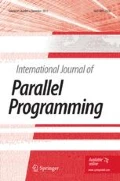Abstract
Nineteen process coordination schemes are comparatively studied and classified to provide operating system designers with a cookbook type manual. The criteria for the classification cover most practically important considerations for process coordination such as process synchronization, nutual exclusions, logical conditions, multiplexing, deadlock prevention, counting of event occurrences, allocation of reusable and consumable resources, explicit perferences among processes, and order of event occurrences. Language levels, implementations, and overhead are also discussed. A suggestion in selecting a proper set of schemes is provided.
Similar content being viewed by others
References
J. L. Baer, “Theoretical aspects of multiprocessing,”Comp. Surveys 5(1):31–80 (March 1973).
P. Brinch Hansen,Operating System Principles. (Prentice-Hall, Englewood Cliffs, New Jersey, 1973).
R. H. Campbell and A. N. Haberman, “The specification of process synchronization by path expression,”Proceedings of an International Symposium on Operating Systems (April 23–25, 1974),Lecture Notes in Computer Science, (Springer, New York, 1974), Vol. 16, pp. 89–102.
R. C. Chen, “Representation of process synchronization,”Proceedings ACM SIGCOMM/SIGOPS Interprocess Communications Workshop, Santa Monica, California (March 24–25, 1975), pp. 37–42.
M. Conway, “A multiprocessor system design,”AFIPS 1963 FJCC (Spartan Books, New York, 1963), pp. 139–146.
E. W. Dijkstra, “Cooperating sequential processes,” InProgramming Languages, F. Genuys, Ed., (Academic Press, New York, 1968), pp. 43–112.
E. Engeler,Introduction to the Theory of Computation (Academic Press, New York, 1973).
R. S. Gaines, “An operating system based on the concept of a supervisory computer,”Comm. ACM (3):150–156 (March 1972).
C. A. R. Hoare, “Monitors: An operating system structuring concept.Comm. ACM 17 (10):549–557 (October 1974).
R. C. Holt, On Deadlock in Computer Systems, Ph. D. Thesis, Cornell University, Ithaca, New York (1971).
S.-T. Hu,Mathematical Theory of Switching Circuits and Automata (University of California Press, Los Angeles, California, 1968).
S. R. Kosaraju, “Limitations of Dijkstra's semaphore primitive and Petri nets,”Fourth Symposium on Operating System Principles, IBM Thomas J. Watson Research Center, Yorktown Heights, New York (October 15–17, 1973), pp. 122–126.
R. J. Lipton, “A comparative study of models of parallel computation,”15th Annual Symposium on Switching and Automata Theory (1974), pp. 145–155.
M. Maekawa, “Detection of parallelism between statements by decomposing into separate sequential processes,”Internat. J. Comp. Inform. Sci. 5 (3):239–255 (September 1976).
M. Maekawa, “Interprocess communications in a highly diversified distributed system,”Information Processing 77 (North-Holland, Amsterdam, 1977).
M. Maekawa, “A consideration of process coordination,”Technical Report, Toshiba Research and Development Center (1978).
R. E. Miller, “A comparison of some theoretical models of parallel computation,”IEEE Trans. Computers C-22:710–717 (August 1973).
S. S. Patil, “Limitations and Capabilities of Dijkstra's Semaphore Primitives for Coordination Among Processes,” Project MAC Computational Structure Group Memo 57.
J. L. Peterson and T. H. Bredt, “A comparison of models of parallel computation,”Information Processing 74 (North-Holland, Amsterdam, 1974).
L. Presser, “Multiprogramming coordination,”Comp. Surveys 7(1):21–44 (March 1975).
J. H. Saltzer, “Traffic Control in a Multiplexed Computer System,” Ph. D. Thesis, MIT, Cambridge, Massachusetts (1966).
H. Vantiborgh and A. Lamsweerde, “On an extension of Dijkstra's semaphore primitives,”Inform. Proc. Letters 1:181–186 (1972).
Author information
Authors and Affiliations
Rights and permissions
About this article
Cite this article
Maekawa, M. A classification of process coordination schemes in descriptive power. International Journal of Computer and Information Sciences 9, 383–406 (1980). https://doi.org/10.1007/BF00978521
Received:
Revised:
Issue Date:
DOI: https://doi.org/10.1007/BF00978521




